Growth in End-Use Industries
The Global Isoprene Monomer Market Industry is significantly influenced by the growth of end-use industries such as automotive, healthcare, and consumer goods. The automotive sector, in particular, is a major consumer of isoprene-based products, including tires and adhesives. As global vehicle production continues to rise, the demand for isoprene monomer is likely to increase correspondingly. Furthermore, the healthcare industry utilizes isoprene in medical devices and products, which is expected to expand as healthcare demands evolve. This multifaceted growth across various sectors indicates a promising outlook for the isoprene monomer market, with projections suggesting a market size of 2.72 USD Billion by 2035.
Rising Demand for Synthetic Rubber
The Global Isoprene Monomer Market Industry experiences a surge in demand for synthetic rubber, primarily driven by the automotive and construction sectors. Synthetic rubber, derived from isoprene, is essential for manufacturing tires, seals, and gaskets. In 2024, the market is projected to reach 1.93 USD Billion, reflecting the increasing production of vehicles and infrastructure projects worldwide. As countries invest in infrastructure development, the demand for high-performance materials like synthetic rubber is likely to grow, thereby enhancing the market for isoprene monomer. This trend suggests a robust growth trajectory for the industry in the coming years.
Emerging Markets and Economic Growth
Emerging markets are playing a pivotal role in the expansion of the Global Isoprene Monomer Market Industry. Countries in Asia-Pacific, particularly China and India, are experiencing rapid industrialization and urbanization, leading to increased demand for isoprene-based products. Economic growth in these regions is fostering investments in infrastructure and automotive production, thereby boosting the consumption of isoprene monomer. As these markets continue to develop, they are expected to contribute significantly to the overall growth of the industry, with a projected CAGR of 3.18% from 2025 to 2035. This trend underscores the importance of emerging economies in shaping the future of the isoprene monomer market.
Technological Advancements in Production
Technological innovations in the production of isoprene monomer are poised to enhance efficiency and reduce costs within the Global Isoprene Monomer Market Industry. Advanced catalytic processes and bio-based production methods are emerging, allowing for more sustainable and cost-effective manufacturing. These advancements not only improve yield but also minimize environmental impact, aligning with global sustainability goals. As companies adopt these technologies, the market is expected to benefit from increased production capacity and lower operational costs, potentially leading to a more competitive landscape. This evolution in production techniques could significantly influence market dynamics in the near future.
Regulatory Support for Sustainable Practices
Regulatory frameworks promoting sustainable practices are becoming increasingly influential in the Global Isoprene Monomer Market Industry. Governments worldwide are implementing policies that encourage the use of bio-based and environmentally friendly materials. This regulatory support is likely to drive the adoption of isoprene monomer derived from renewable resources, aligning with global sustainability initiatives. As manufacturers adapt to these regulations, the market may witness a shift towards greener production methods, enhancing the appeal of isoprene monomer in various applications. This trend suggests that compliance with environmental standards could become a key driver of market growth.
















